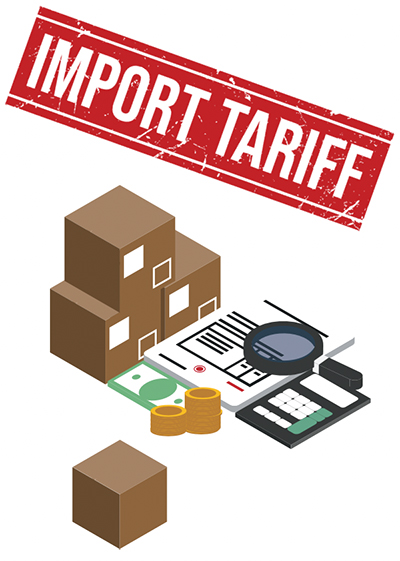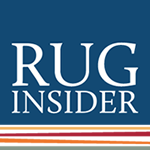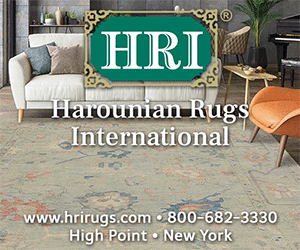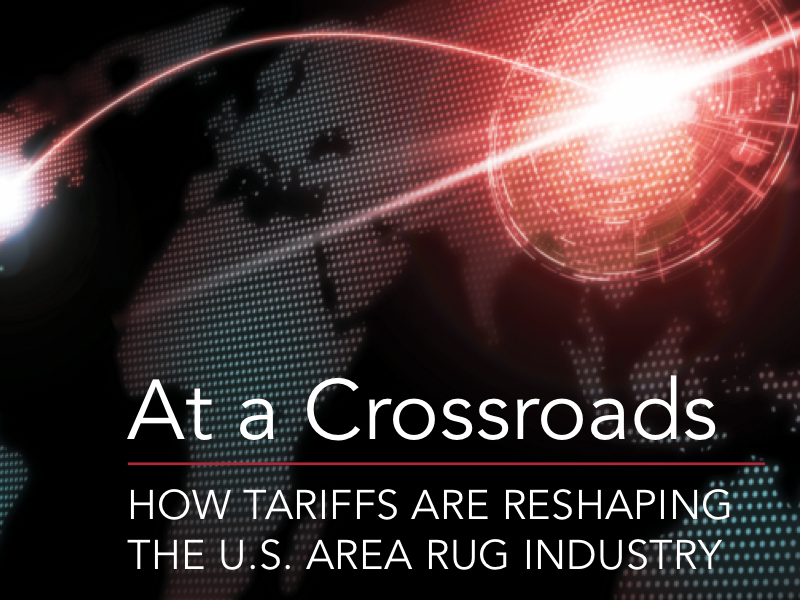From domestic production to global diversification, the soft flooring industry is confronting a new era of trade challenges.
As the U.S. area rug industry navigates a shifting global trade landscape, tariffs have emerged as a powerful dichotomy—at once a disruptive force and a catalyst for reinvention. Manufacturers, suppliers, and retailers alike are recalibrating sourcing, pricing, and distribution strategies to adapt and stay flexible, all while contending with the broader headwinds of inflation, volatile shipping logistics, and persistent economic uncertainty.
What began as anxiety over rising costs and compressed margins has evolved into a more layered reality. Industry leaders now describe a marketplace in flux, defined as much by strategic adaptation and new opportunity as by constraint. Domestic producers are capitalizing on renewed interest in U.S.-made goods, while importers are navigating tariff complexity with sharpened agility—positioning the area rug sector at a consequential crossroads.
Consumers’ Price Sensitivity and Retail Realities
Recent insights from leading industry research group Circana (formerly NPD Group) sharpen the lens on the consumer side. Marshal Cohen, Chief Retail Advisor, notes that consumers typically tolerate a 10-percent to 12-percent price increase without significant pushback. “Retailers will likely promote their way out of tariff-related price pressures,” Cohen says, citing early examples of “no tariff pricing” campaigns designed to capture consumer attention and loyalty amid uncertainty.
However, the tariff impacts ripple more intensely through manufacturers, suppliers, and logistics providers than at the retail shelf. Cohen explains that the supply chain is already adjusting — with some manufacturers pulling forward orders, holding inventory to wait out tariff shifts, and retailers seeking “must-have pricing” from wholesalers to preserve margins amid rising costs. This will likely result in fewer promotions, forcing consumers to prioritize purchases and potentially trade down or switch brands.
Larger retailers with robust inventories appear poised to capitalize on these shifts. “The pandemic showed us how premium freight space can be,” Cohen observes, underscoring the value of early broker collaboration and supplier credit negotiations. “In this environment, nimbleness and scenario planning are key.”
Domestic Manufacturing: A New Growth Frontier
For some industry players, tariffs present a rare opportunity to spotlight the value and renewed relevance of domestic manufacturing. Wade Maples, co-owner of Maples Rugs, a family-run domestic manufacturer, views tariffs as a potential “leveling force” in a market long dominated by imports.
Tariffs have forced a new conversation about the value of American-made rugs — and that conversation is just getting started,” he said to RUG INSIDER. “Our hope is that tariffs encourage retailers to take a fresh look at American suppliers—not just in terms of logistics, but quality, lead times, and flexibility.” Early signals are promising, he adds, with retailers increasingly exploring USA-made programs as a hedge against overseas sourcing risks.
Maples points to an A/B test with Amazon, where click-through rates on products labeled “Made in the USA” surged—a clear sign that consumers value domestically produced goods. “Retailers are not just hedging; they are actively rebalancing their assortments to be less import-dependent,” he notes. The ability to move quickly on design and production is a distinct advantage to Maples Rugs, he cites. “We can step in fast and fill gaps or launch new programs, which is increasingly important in this volatile environment.”
Natco Home echoes this optimism. President Michael Litner describes plans to expand the company’s domestic productions of woven rugs in Maine and tufted rugs in Georgia, including new loom installations to meet growing demand. Still, there are challenges: “Retailers are conservative now, with some canceling or pushing out orders, sharing tariff burdens with suppliers, or cutting programs reliant on China.” Despite these headwinds, he sees strong potential for brands focused on USA-made products.
The Handmade Rug Sector Faces Unique Challenges
Not all segments share the same outlook. Handmade rug importers like Creative Touch, which sources primarily from India and Turkey, face more acute pressures. Founder Baki Ildiz recounts the “ripple effect” of reciprocal tariffs in those countries, making quote requests difficult to finalize and squeezing already thin margins.
“We absorbed tariff costs [on prior shipments because contracts were fixed],” Ildiz explains to RUG INSIDER. “Going forward, we had to add clauses for tariff volatility to protect our business.”
Since handmade rugs cannot be domestically produced at scale, tariffs effectively raise consumer prices, risking a shift away from middle-income buyers. Ildiz fears this will push the market toward mass-produced, lower-quality rugs, threatening the craftsmanship and ethical values that define the handmade category.
Despite these challenges, Creative Touch remains committed to quality and sustainability. “We will not sacrifice craftsmanship or our mission,” Ildiz says.
Agility and Diversification
Companies with diversified global footprints report that tariffs, while difficult, validate their strategic choices. Creative Matters, a Canadian company with production across Nepal, Thailand, India, and the U.S., has leveraged its multi-country sourcing and internal logistics to shield clients from the worst tariff impacts.

Ali McMurter, Managing Partner Creative Matters, Photo: Creative Matters
Managing Partner Ali McMurter describes a “futureproof” model built on diversification and tight control of design, production, and shipping. “Tariffs create volatility, but they also drive clients to partners who offer stability and solutions, not just products,” she notes. The company’s ability to pivot production and reallocate orders across regions has become a competitive advantage.
“Tariffs create volatility, but they also drive clients to partners who offer stability and solutions, not just products.“ ALI MCMURTER, CREATIVE MATTERS
This approach aligns with broader market demands. Retailers increasingly seek suppliers that can manage risk, control lead times, and preserve margins amid an uncertain geopolitical landscape. “Cross-border thinking” and vertically integrated models are emerging as industry best practices.
Retailers Grapple with Margin Pressures and Inventory Shifts
Tariff pressures are surfacing clearly in retailers’ financial disclosures and forward-looking statements. Major national chains that carry area rugs, like TJX Companies, Kohl’s, Burlington Stores, Macy’s, Walmart, Target, and Ross Stores, all referenced tariffs in their recent quarterly reports, revealing a landscape of cautious and collaborative adaptation.
- TJX CFO John Klinger highlighted the company’s global vendor network and reassured investors that merchandise availability remains solid despite China sourcing disruptions. CEO Ernie Herrman emphasized the flexibility to shift assortments and vendors as needed to avoid empty shelves.
- Kohl’s CFO Jill Timm pointed to sourcing diversification since 2017 as a buffer against tariff pressures. The company offsets higher costs by adjusting order mix and inventory levels.
- Burlington Stores detailed a strategic “remix” of margin plans, including opportunistic purchases of pre-tariff merchandise and adjustments to reserve inventory, which comprised nearly half of total stock as of May.
- Macy’s disclosed order cancellations and delays where tariffs bite hardest, adopting a “surgical” approach to price adjustments that includes renegotiations and vendor discounts.
- Walmart’s CEO Doug McMillon acknowledged the inevitability of higher prices due to tariffs but stressed efforts to minimize consumer impact through selective cost spreading across categories.
- Target CEO Brian Cornell described a “high difficulty level” in managing tariff-driven cost increases, stressing that price increases remain a last resort.
- Ross Stores, heavily reliant on China imports, reported merchandise margin declines tied to ocean freight and tariffs, with CEO Jim Conroy anticipating broad-based inflationary pressures in retail pricing.

Suppliers Absorbing Costs and Navigating Customer Relationships
Supplier responses reveal the tension between absorbing tariff costs and maintaining customer relationships. Kalaty Rugs, for example, chose to absorb a recent 10-percent tariff increase to shield customers from immediate price hikes during a 90-day tariff hold.
Wendy Reiss, VP of Sales and National Accounts at KAS Rugs, explained to RUG INSIDER the company’s decision to drop three collections sourced from China amid tariff uncertainty. Kas is holding prices steady on current inventory to encourage retailer stocking while exploring alternative sourcing options. “We’re staying one step ahead,” she says, emphasizing agility in a volatile market.
Natco Home’s Litner cites a mixed response to its strategies from its retail partners, with some sharing tariffs with suppliers and others canceling or delaying orders, reflecting a more cautious buying environment.
The recently announced liquidation of Culver City, CA’s H.D. Buttercup—a home furnishings icon renowned for luxury and artisan-made pieces — underscores the economic challenges confronting the sector. Tariffs, alongside broader economic uncertainty, disrupted the company’s business model, leading to store closures while searching for potential buyers.
This closure symbolizes the difficult terrain many retailers face, where margin pressures and supply chain volatility require new operating models.
While tariffs have undeniably introduced complexity and cost pressures, they have also accelerated industry trends toward domestic production, supply chain diversification, and operational agility. For the U.S. area rug market, this moment presents an opportunity albeit with challenges: adapt with nimbleness, innovation, and strategic foresight to emerging stronger.
 |
As conditions evolve, companies across the area rug sector are identifying important strategic priorities. Here are some tips collected from industry players and experts for tackling uncharted tariff impacts ahead: Emphasize Flexibility and Scenario Planning Leverage Domestic Manufacturing Diversify Sourcing Footprints Communicate Transparently Invest in Innovation and Marketing |





